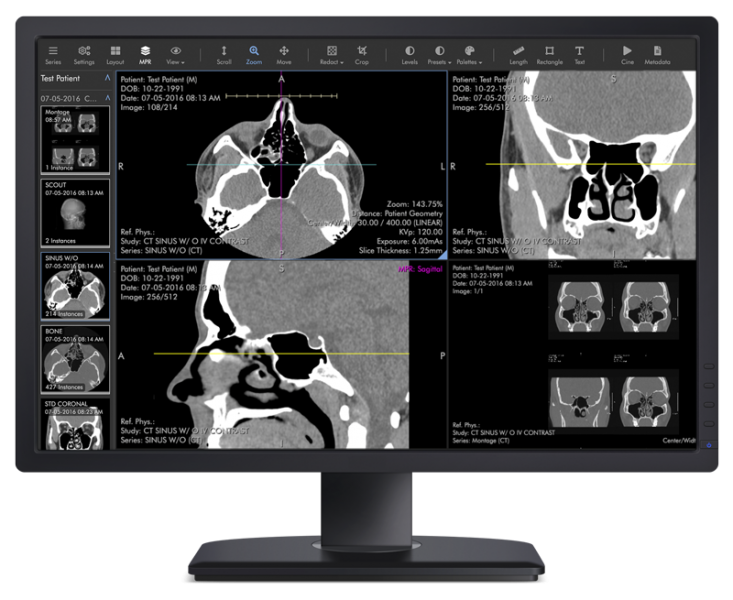BLOG: A Patient First Approach to Improving Imaging Accessibility and Usability

Ambra Health recently launched the Ambra ProViewer, which allows for mobile access for quick reads, and full diagnostic teleradiology capabilities from any device with a major web browser.
The COVID-19 pandemic accelerated a change that was already occurring in imaging-heavy practices across the country — the shift to a cloud-based system with a light footprint and easy accessibility for remote diagnostic viewing. The cloud environment provides easy access to data from anywhere, but it’s the tools within the cloud viewing suite that Brian Gay, M.D., owner of First Look MRI in Atlanta and cloud technology early-adopter, finds most helpful in his practice.
First Look MRI places emphasis on patient communication as a differentiator, and Gay relies on Ambra Health’s newly launched ProViewer to prepare reports that are easy for patients to understand. He often uses ProViewer’s tooling feature to embed an image within a scan to share with a patient as these images can also be easily annotated within the viewer.
“When the patient gets a report of the written words, that may not mean much to them; but they'll see those couple pictures and say, ‘Oh, that's my meniscus tear. There's a big arrow there.’ So I love that ability,” Gay said.
Ambra Health’s ProViewer is a cloud-based diagnostic image viewer that expands on the capabilities of their existing viewer with advanced capabilities. The ProViewer allows for mobile access for quick reads, and full diagnostic teleradiology capabilities from any device with a major web browser. The ProViewer also has advanced tool sets including multi-planar reconstruction, surface and volume rendering and anatomical reordering.
When asked, why Ambra, Gay notes, “A big selling point about the Ambra ProViewer is the ease of changing the tools. Ambra makes it really easy for the user to add a tool or subtract a tool, just intuitively. You just click on the tool to make it disappear, or add a tool. To configure the tools easily is a huge plus.”
As the pandemic forced radiology practices to dramatically shift their workflows to accommodate clinician and patient needs, the rest of the radiology community quickly discovered what the early-adopters already knew: an easily accessible, remote solution that enables collaboration will provide a wealth of benefits lasting well beyond the current pandemic crisis.
“We found a number of institutions hurrying up their process of deploying cloud,” said Morris Panner, CEO of Ambra Health, which saw tremendous customer interest in cloud technology in spring 2020. “All of a sudden, we found ourselves scrambling. In the way that people were having trouble buying toilet paper, we were having trouble provisioning servers fast enough inside of our various environments, because usage was moving that rapidly. And all of a sudden having that capability, and expanding upon it, was critical.”
Cloud access and collaboration tools also mean that physicians can easily ask colleagues for second opinions from specialists around the world. Users can invite anyone to log in to view an image.
“They don't have to worry about getting a complex system of their own or whether their image will work on their system or whether it has a bug or virus. They can simply open their browser-based device and give me a view,” Panner said. “And we are seeing an explosion in care being elevated because now you can access the best opinions in the world. And what we love about that is we think that's what everybody should have.”
Not only do cloud-based technology and collaboration tools provide better coordination among physicians and practices, but it also improves communication and interaction with patients.
“Out of the pandemic, I think we saw tremendous stress on the system, for those seeing care for other conditions, who were really being boxed out of the system,” Panner said. “We have seen a virtualization and a rethinking of how infrastructure should be deployed. And that means being able to reach the patient virtually. That’s probably been one of the largest outcomes of this, which in many ways is tremendously positive.”
Editor’s Note: This is the third blog in a series about sharing patient images. The first BLOG: Why Image Transfer Needs To Be Electronic, can be found here. The second BLOG: How Artificial Intelligence Can Help In Image Transmission of Images, can be found here.
Related Artificial Intelligence Content:
BLOG: Why Image Transfer Needs To Be Electronic
VIDEO: AI That Second Reads Radiology Reports and Deals With Incidental Findings
Webinar: HIMSS Webinar: Healthcare Trends to Watch for in 2020



 December 10, 2025
December 10, 2025 









